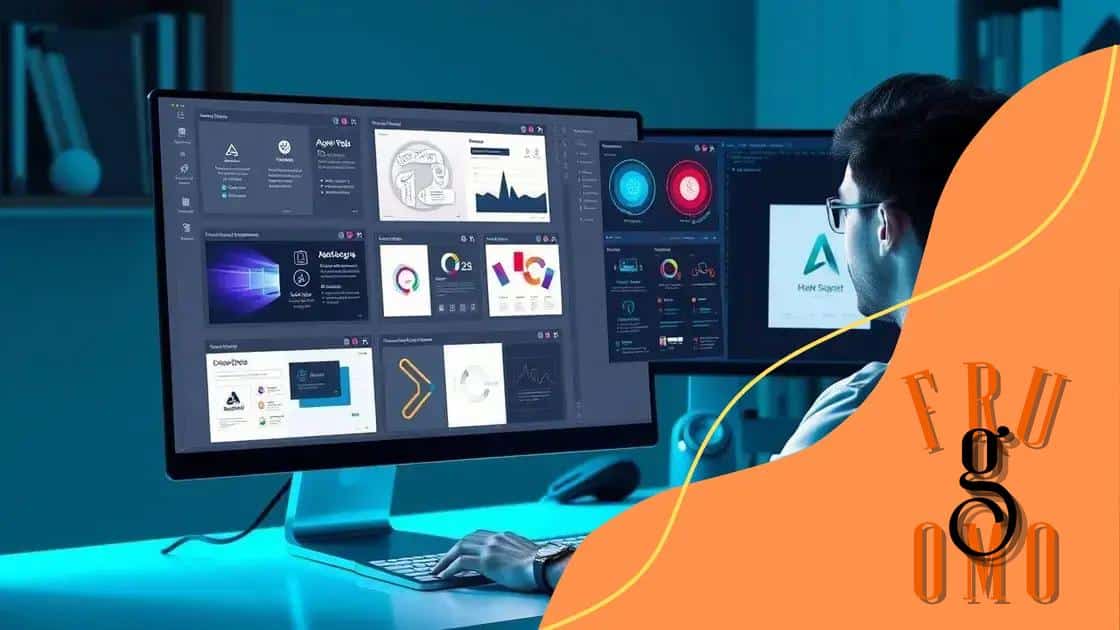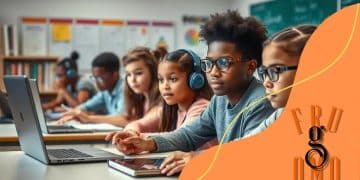The role of AI in transforming the creative industries

The role of AI in transforming the creative industries involves enhancing creativity, personalizing content, and streamlining production processes, while also raising ethical concerns about originality and job security.
The role of AI in transforming the creative industries is becoming increasingly significant. Have you noticed how technology influences creativity? In this article, we will explore the various ways AI is reshaping the creative landscape and what it means for artists and creators.
How AI is changing artistic creation
AI’s influence is increasingly felt in artistic creation, allowing artists to explore new avenues of expression. As technology advances, creators can leverage AI tools to push the boundaries of their work.
AI Tools Enhancing Creativity
Among the various ways AI impacts artistic creation, we find tools that automate tasks, generate ideas, and assist in design processes. These tools can help artists focus on what truly matters—their vision.
- AI-generated visuals: Algorithms can create images based on simple user inputs, opening possibilities for unique art styles.
- Music composition: AI can assist musicians in developing melodies, harmonies, and even entire compositions.
- Style transfer: Artists can apply styles from famous works to their creations, creating new interpretations.
Moreover, AI can analyze trends in the art world, helping artists stay relevant and informed. By examining popular themes and techniques, creators can better align their works with audience interests.
As artists utilize AI tools, a dynamic relationship forms. Traditional techniques and modern technology combine, creating a rich tapestry of original art. This fusion leads to exciting developments in multiple disciplines, from visual arts to music.
Challenges in the Art World
However, this evolution is not without its challenges. Some artists express concerns about AI replacing human creativity or diluting authenticity. Are we risking the essence of art by relying too heavily on technology?
Despite these concerns, AI’s role in artistic creation continues to grow, inviting discussions on ethics and the future of art. Ultimately, artists must navigate this landscape, deciding how to best integrate AI into their processes.
The impact of AI on content production
The impact of AI on content production has been revolutionary. It allows creators to automate repetitive tasks, helping them focus on crafting high-quality content.
Streamlined Workflows
With AI tools, content production becomes faster and more efficient. These tools can analyze data and provide insights, enabling creators to tailor their work to meet audience preferences.
- Automated editing: AI can assist in editing videos and articles, saving time and ensuring quality.
- Content recommendations: Algorithms analyze user behavior to suggest topics that resonate with audiences.
- Real-time feedback: AI provides immediate analysis of content performance, allowing for quick adjustments.
As AI continues to evolve, its role in content creation grows. Writers can rely on AI for brainstorming ideas, which helps them overcome writer’s block. This technology fosters creativity by suggesting alternative angles and new ideas.
Furthermore, by enhancing SEO practices, AI ensures that content reaches the right audience. It can optimize headlines, suggest keywords, and improve readability, making articles more engaging.
Personalization and Engagement
Personalization is another area where AI shines. By analyzing user preferences, AI can help producers create customized content aimed at specific demographics. This level of personalization increases user engagement and retention.
As AI integration expands, it challenges traditional content production methods. Questions about authenticity arise as automated systems create works. Nevertheless, embracing AI can lead to more innovative and informed content production strategies.
AI tools enhancing design processes

AI tools are significantly enhancing design processes, making them more efficient and innovative. Designers can now leverage technology to streamline their workflows and create stunning visuals.
Automation in Design
Automation through AI allows designers to focus on creativity rather than repetitive tasks. For instance, AI can handle tasks like resizing images or generating color palettes based on existing designs.
- Smart resizing: AI tools can automatically resize images for different platforms, ensuring consistency.
- Color scheme generators: These tools suggest color combinations that are aesthetically pleasing, saving time in the design phase.
- Template generation: AI can create design templates based on user preferences, making the starting point easier for designers.
Moreover, AI-powered design software can analyze user data and trends, providing insights that guide the creative process. This means designers can tailor their work to align with current trends or specific audience interests, creating more relevant designs.
As AI continues to develop, collaboration between human designers and machine learning algorithms becomes crucial. Some tools assist in brainstorming sessions, offering design suggestions based on keywords or themes provided by the user.
Enhancing User Experience
AI tools also help improve user experience design. By analyzing user interactions, they can offer suggestions on layout changes that could enhance usability. As user preferences evolve, AI enables designers to adapt easily, fostering a more responsive design environment.
With the incorporation of AI, the design process has become faster and more creative. It frees up time for designers to experiment with new ideas, ultimately pushing the boundaries of what design can achieve.
Challenges faced by creators with AI
Creators face several challenges when integrating AI into their processes. While AI offers many benefits, it also brings questions about ethics, creativity, and job security.
Ethical Concerns
One major challenge is the ethical implications of using AI. As machine learning algorithms generate content, issues of ownership and originality arise. Can a piece created by AI truly be considered an authentic work of art?
- Copyright issues: Determining who owns AI-generated content can lead to legal disputes.
- Bias in algorithms: AI systems can perpetuate biases present in training data, leading to skewed results.
- Manipulation of content: There are risks of AI being used to create misleading or harmful information.
These ethical challenges require careful consideration by creators. It is essential for them to engage with the technology responsibly and maintain transparency in their work.
Impact on Creativity
Another significant concern is the potential impact on creativity. Some artists wonder if relying on AI might stifle their unique voice. Will the use of AI tools lead to a homogenization of artistic expression?
This worry isn’t unfounded; however, AI can also serve as a new creative partner. It can provide inspiration or suggestions, but creators should balance its use with their personal touch.
Additionally, job security emerges as another challenge. As AI becomes more capable, there is a fear that human roles in creative industries may diminish. How can creators adapt to a landscape where AI plays a dominant role?
To combat these challenges, creators must embrace lifelong learning. Staying updated with technological advancements and exploring new tools can help maintain their relevance in the industry.
Future trends of AI in the creative sector
Future trends of AI in the creative sector are poised to revolutionize the way content is created and consumed. As technology advances, the collaboration between humans and AI will become even more seamless.
Increased Personalization
One major trend is the rise of personalized content. AI will enable creators to deliver tailored experiences for audiences based on their preferences and behaviors. This means that art, music, and writing can resonate more deeply with individual consumers.
- Data-driven insights: AI will analyze user data to create content that matches specific interests.
- Customized recommendations: Algorithms will suggest music, books, and art based on unique user profiles.
- Adaptive storytelling: Interactive narratives will change based on audience choices, creating a unique experience for each user.
Additionally, AI’s ability to predict trends will help creators stay ahead of the curve. By analyzing past data, AI can identify emerging themes and styles that resonate with audiences.
Collaborative Creativity
Another significant trend is the concept of collaborative creativity. AI will assist artists in brainstorming ideas and even generating concepts that can be further developed. For instance, musicians can work with AI to create innovative melodies or help visual artists generate unique visual themes.
Furthermore, AI can enhance the collaboration process by providing tools that facilitate communication among creative teams. This can lead to more innovative projects that blend different artistic mediums.
As AI becomes increasingly integrated into the creative sector, ethical considerations will need to be addressed. Questions about originality and authenticity may arise, requiring ongoing dialogue among creators, technologists, and audiences.
In the end, the future of AI in the creative sector looks promising. The blend of technology and human creativity will transform traditional practices, making room for new forms of expression and artistic exploration.
In summary, the integration of AI into the creative industries is transforming how we create and engage with art, music, and storytelling. As we embrace new technologies, we must also navigate challenges like ethics and authenticity. The future of creativity lies in finding a balance between human imagination and AI assistance, potentially leading to innovative ideas that were once unimaginable. AI will play a pivotal role in shaping this new landscape, offering exciting opportunities for creators around the world.
FAQ – Frequently Asked Questions about AI in the Creative Industries
How does AI help in enhancing creativity?
AI assists artists by providing inspiration, generating ideas, and streamlining repetitive tasks, allowing them to focus on the creative process.
What are some ethical concerns related to AI in creativity?
Ethical concerns include issues of originality, copyright ownership, and the potential for AI to perpetuate biases in creative works.
Can AI replace human artists and creators?
While AI contributes to creativity, it complements human skills rather than replaces them, enhancing the creative process when used alongside human talent.
What future trends can we expect from AI in the creative sector?
Future trends may include increased personalization of content, collaboration between humans and AI, and the development of adaptive storytelling based on user interactions.





